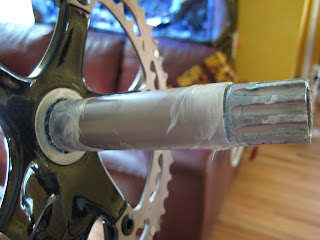First we need to mount the levers. The convention is to mount them so that the bottom tip of the lever is even with the line of the lowest point of the drops. You can hold a straight edge under the handlebar drop extending forward and position the lever so that it rests on the straightedge.
Since this is a new build with new parts, running the cables is actually the most time consuming part. You must cut the cable housing to the correct length so it doesn't cause the cables to bind. Everything should have smooth curves and easy transitions.
There are two basic lever terms you will hear - aero levers and non-aero levers. Aero levers run the cables under the bar tape and exit near the stem. Non-aero leaves the cable housing flying in the wind. The aero look cleaner but I really like the vintage look of the cables looping up. How often did riders get tangled in these cables that necessitated this change?
Examples here are Campy Veloce on the left and campy non-aero on the right.

The SRAM Force levers I'm using and all modern levers with integrated shifters (sometimes called "Brifters") will be aero style. These require the brakes and the shifter cables to run under the bar tape.

When routing cables housing for aero levers, make sure you tape down the cable housings every few inches along the bars, the last place being where you anticipate your bar tape ending near the stem. For comfort, keep them from running right along where the heel of your hand will be. Though they will be covered with tape later, this will help the cable housing take the final shape and ensure you leave the length needed. I used electrical tape but any tape will work.
Cutting the cable housing is best done with a cutoff wheel on a Dremel or preferably larger motor. I used a 4" cutoff blade. It might help to tape around the housing first to prevent plastic fraying but it isn't necessary. What really helps is to hit the cut end with a fast moving sander of some sort. This will square it up quickly and keep the Teflon inner lining, the metal sheath, and the outer plastic from separating. The process is a matter of trial and cut for each cable. I started with my brake cables and ran the shifter cables last The shifter cables are not as beefy as the brake cables so remember what you are doing before you measure and cut the wrong one. Remember the old saying, "Measure twice, cut once."
The front brake cable is easy as the bars, cable, fork, and caliper all turn together - no binding issues. The rest will require a little concentration and forethought of where things will move when it's all done. Generally, you want enough slack so that you can turn the bars all the way to the left and right without binding.





























